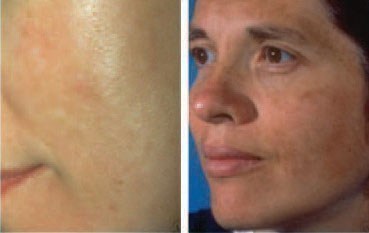Melasma

Melasma: The forehead is a common place for melasma to appear.
Melasma (muh-LAZ-muh) is a common skin problem. It causes brown to gray-brown patches on the face. Most people get it on their cheeks, bridge of their nose, forehead, chin, and above their upper lip. It also can appear on other parts of the body that get lots of sun, such as the forearms and neck.
Sun exposure triggers melasma.
One of the most common treatments for melasma is sun protection. This means wearing sunscreen every day and reapplying the sunscreen every 2 hours. Dermatologists also recommend wearing a wide-brimmed hat when you are outside. Sunscreen alone may not give you the protection you need.
Women are far more likely than men to get melasma. It is so common during pregnancy that some people call it the mask of pregnancy. Hormones seem to trigger melasma.
Melasma: Signs and symptoms
Common signs (what you see) of melasma are brown or gray-brown patches on the face. These patches most commonly appear on the:
- Cheeks.
- Forehead.
- Bridge of the nose.
- Above the upper lip.
- Chin.
Some people get patches on their forearms or neck. This is less common.
Melasma does not cause any symptoms (what people feel). But many people dislike the way melasma makes their skin look.

Melasma: Blothcy patches of darker color often appear on the cheeks. The woman on the right developed the brown patches while pregnant.
Melasma: Diagnosis, treatment, and outcome
How do dermatologists diagnose melasma?
Dermatologists can diagnose most patients by looking at their skin. To see how deeply the melasma penetrates the skin, your dermatologist may look at your skin under a device called a Wood’s light.
Sometimes melasma can look like another skin condition. To rule out another skin condition, your dermatologist may need to remove a small bit of skin. This procedure is called a biopsy. A dermatologist can safely and quickly perform a biopsy during an office visit.
How do dermatologists treat melasma?
Melasma can fade on its own. This often happens when a trigger is causing the melasma, such as a pregnancy or birth control pills. When the woman delivers the baby or stops taking the birth control pills, melasma can fade.
Some people, however, have melasma for years — or even a lifetime. If the melasma does not go away or a woman wants to keep taking birth control pills, melasma treatments are available. These include:
- Hydroquinone: This medicine is a common first treatment for melasma. It is applied to the skin and works by lightening the skin. You will find hydroquinone in medicine that comes as a cream, lotion, gel, or liquid. You can get some of these without a prescription. These products contain less hydroquinone than a product that your dermatologist can prescribe.
- Tretinoin and corticosteroids: To enhance skin lightening, your dermatologist may prescribe a second medicine. This medicine may be tretinoin or a corticosteroid. Sometimes a medicine contains 3 medicines (hydroquinone, tretinoin, and a corticosteroid) in 1 cream. This is often called a triple cream
- Other topical (applied to the skin) medicines: Your dermatologist may prescribe azelaic acid or kojic acid to help lighten melasma.
- Procedures: If a topical medicine does not get rid of your melasma, a procedure may succeed. Procedures for melasma include a chemical peel (such as glycolic acid) and dermabrasion. A dermatologist should perfrom these procedures. New skin problems can occur when the person who gives the treatment does not tailor it to the patient’s skin type.
Ask your dermatologist about possible side effects (health problems that can result from the treatment).
If you notice any of the following after treating melasma, be sure to call your dermatologist:
- Skin irritation.
- Darkening of the skin.
- Other problems.
Outcome
Under a dermatologist’s care, many people with melasma have a good outcome. Melasma can be stubborn, though. It may take a few months of treatment to see improvement. It is important to follow your dermatologist’s advice. This ensures that you get the most benefit from treatment. It also can help avoid skin irritation and other side effects.
After your melasma clears, you may need to keep treating your skin. Your dermatologist may call this maintenance therapy. Maintenance therapy can prevent melasma from returning.
You can help prevent your melasma from returning by wearing sunscreen and a wide-brimmed hat every day.



